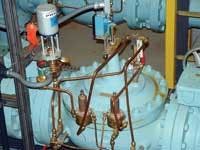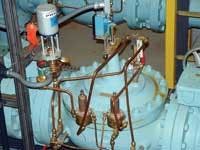Serving the Municipality of Anchorage, Alaska, Anchorage Water and Wastewater Utility (AWWU) is the largest water and wastewater utility in the state. AWWU has over 54,000 water customer accounts that equates to an approximate population base of 220,600 residents.
“AWWU has over 55 pressure zones to operate. These pressure zones are fed from multiple sources and require adjustments from a central location to balance the varying demands placed on our water distribution system. In fact, the seasonal fluctuations place a high need on this ability,” said Richard Steckel, AWWU’s general foreman.
Due to Alaska’s unique climate, at times, fluctuations happen overnight. Water demands fluctuate between 60 mgd during warm summer days and 25 mgd during cooler weather.
To address the issue, in the summer of 2003 AWWU decided to replace its manually operated pilot valves with an automated system. The utility’s engineering consultant contacted Singer Valve sales representative Bob Ford, president, Gene Ford Co., and Grant LaBar, territory manager for Singer.
The suggested solution was to install Singer 420-DC Automated Pilots that would give operators the ability to remotely control and make pressure changes from multiple locations using the utility’s SCADA system.
With the 420-DC, a slow speed 24 vDC motor actuator drive is fitted to a standard Singer Valve pilot. The minimum system pressure downstream of the pressure reducing valve is set by adjusting the pilot screw that compresses the pilot spring. The motor actuator responds to a 4-20mA signal, rotating the pilot adjusting screw corresponding to the change in signal. The number of turns is adjustable and may be programmed to suit the pressure change per turn of the pilot screw to produce the desired maximum and minimum downstream pressure.
The system requires less than one amp of power to operate. Extended power failure would result in constant pressure at the last setting. Optional freeze or default to high or low pressure is available on loss of signal.
“The replacements pilots gave us the remote capabilities we needed to balance our distribution system as well as a means to identify problems with pressure regulating valves,” Steckel said. “We are also able to force pumps on and off by changing the hydraulic parameters within our pressure zones and control which sources we use to meet our customers water needs.
“The ability to make needed changes remotely through AWWU’s new SCADA system has reduced the number of trips employees routinely make to the many booster stations and pressure regulating vaults in our distribution system,” he said.




